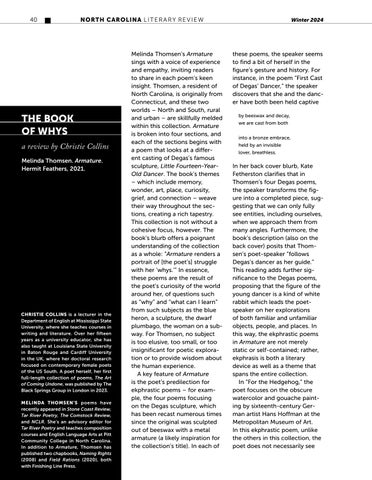40
NORTH CAROLINA L I T E R A R Y RE V I E W
THE BOOK OF WHYS a review by Christie Collins Melinda Thomsen. Armature. Hermit Feathers, 2021.
CHRISTIE COLLINS is a lecturer in the Department of English at Mississippi State University, where she teaches courses in writing and literature. Over her fifteen years as a university educator, she has also taught at Louisiana State University in Baton Rouge and Cardiff University in the UK, where her doctoral research focused on contemporary female poets of the US South. A poet herself, her first full-length collection of poems, The Art of Coming Undone, was published by The Black Springs Group in London in 2023. MELINDA THOMSEN’S poems have recently appeared in Stone Coast Review, Tar River Poetry, The Comstock Review, and NCLR. She’s an advisory editor for Tar River Poetry and teaches composition courses and English Language Arts at Pitt Community College in North Carolina. In addition to Armature, Thomsen has published two chapbooks, Naming Rights (2008) and Field Rations (2020), both with Finishing Line Press.
Melinda Thomsen’s Armature sings with a voice of experience and empathy, inviting readers to share in each poem’s keen insight. Thomsen, a resident of North Carolina, is originally from Connecticut, and these two worlds – North and South, rural and urban – are skillfully melded within this collection. Armature is broken into four sections, and each of the sections begins with a poem that looks at a different casting of Degas’s famous sculpture, Little Fourteen-YearOld Dancer. The book’s themes – which include memory, wonder, art, place, curiosity, grief, and connection – weave their way throughout the sections, creating a rich tapestry. This collection is not without a cohesive focus, however. The book’s blurb offers a poignant understanding of the collection as a whole: “Armature renders a portrait of [the poet’s] struggle with her ‘whys.’” In essence, these poems are the result of the poet’s curiosity of the world around her, of questions such as “why” and “what can I learn” from such subjects as the blue heron, a sculpture, the dwarf plumbago, the woman on a subway. For Thomsen, no subject is too elusive, too small, or too insignificant for poetic exploration or to provide wisdom about the human experience. A key feature of Armature is the poet’s predilection for ekphrastic poems – for example, the four poems focusing on the Degas sculpture, which has been recast numerous times since the original was sculpted out of beeswax with a metal armature (a likely inspiration for the collection’s title). In each of
Winter 2024
these poems, the speaker seems to find a bit of herself in the figure’s gesture and history. For instance, in the poem “First Cast of Degas’ Dancer,” the speaker discovers that she and the dancer have both been held captive by beeswax and decay, we are cast from both
into a bronze embrace, held by an invisible lover, breathless.
In her back cover blurb, Kate Fetherston clarifies that in Thomsen’s four Degas poems, the speaker transforms the figure into a completed piece, suggesting that we can only fully see entities, including ourselves, when we approach them from many angles. Furthermore, the book’s description (also on the back cover) posits that Thomsen’s poet-speaker “follows Degas’s dancer as her guide.” This reading adds further significance to the Degas poems, proposing that the figure of the young dancer is a kind of white rabbit which leads the poetspeaker on her explorations of both familiar and unfamiliar objects, people, and places. In this way, the ekphrastic poems in Armature are not merely static or self-contained; rather, ekphrasis is both a literary device as well as a theme that spans the entire collection. In “For the Hedgehog,” the poet focuses on the obscure watercolor and gouache painting by sixteenth-century German artist Hans Hoffman at the Metropolitan Museum of Art. In this ekphrastic poem, unlike the others in this collection, the poet does not necessarily see
